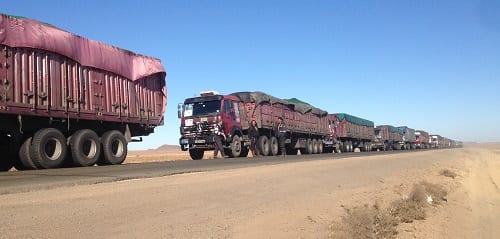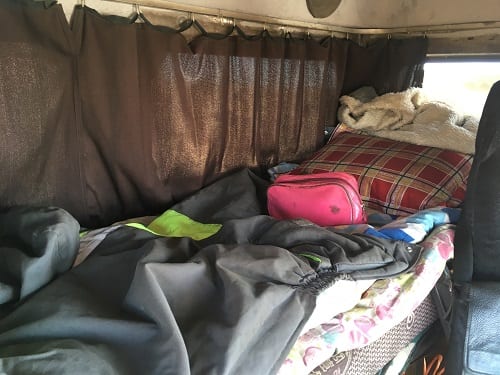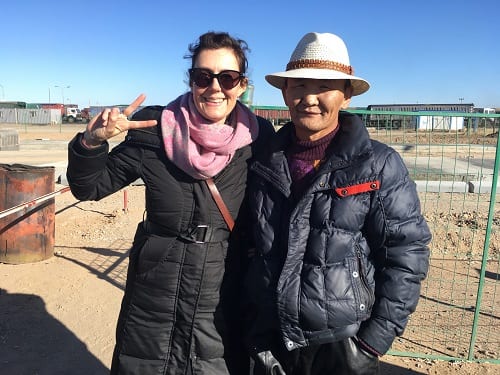A Project Visit to ‘Mongolian Korea’ (Mongolyn Solongos)
By ucsadul, on 10 November 2016
13 people from the Emerging Subjects team, from NUM and UCL, are currently on group fieldwork visiting the major mines and their communities in the South Gobi. We have visited Energy Resources’ coal mine Ukhaa Khudag in Tsogttsesii and the gold and copper mine of Oyu Tolgoi in Khan Bogd. We have also met with herders, such as Namsrai, and his family displaced by the mine, and a member of Khan Bogd’s citizens’ representative council, Batsengel.
Today we travelled to the border crossing between Mongolia and China, Gashuun Sukhait-Gants Mod, and met with the coal truck drivers (Nuursnii jolooch) who travel along this road, as well as the traders, border workers, money changers along this route, as well as meeting several hundred camels.
Here is a short video interview with Batbayar (from Hovsgul) from the inside of his truck as he drives toward the border. Batbayar explains the circular route of the truck drivers from the mines in Mongolia to the deposits in China, via the border crossing and along the coal road. The number of trucks on this road is approximately 3,500 in total.

The truck driver, Batbayar, from Khovsgol, who delivers Tavan Tolgoi coal to China. Photo by Bum-ochir Dulam.
It takes about one week to do the circular route in full (collecting the coal from the mine in Mongolia and bringing it to China to the buyer), but sometimes it can take three days, when two trips by one driver can be made in one week.
Each truck is 40 tons, the cargo is 60 tons and together they weigh 100 tons. The trucks are weighed on the Chinese side to assess how much coal is being bought.

Coal trucks waiting for the border point at Gashuun Sukhait to open. Photo by Munkh-erdene Gantulga.
The majority of drivers do not own the trucks which they drive (there is a minority that do own their truck or are leasing to own, and they are usually not hauling Erdenes TT coal). It is mostly Chinese companies who own the trucks which have Mongolian number plates, and stickers adorn the front of cabin with the Chinese companies they are collecting coal for. Previously Chinese drivers were employed but the cost of employing them to work in Mongolia has proved prohibitive for the Chinese companies.

While waiting on the long line between Tsagaan Khad and Gashuun Sukhait, a driver gets some sleep with his feet up on the dashboard. Photo by Rebekah Plueckhahn.
Most of the trucks have Mongolian drivers (we met one driver who worked for a Mongolian company, and there are also a few Chinese drivers). The coal is mostly being taken from Tavan Tolgoi, whereas the cooking coal from Energy Resources is mostly being stock piled along the side of the road, waiting to be sold when the market improves.
Batbayar receives 300,000 tgs per month and 250,000 per delivery, which is paid to him in Yuan on the Chinese side of the border once he has delivered the coal to the hanger where it is stored before the Chinese company takes it (probably by rail) to their factory. He goes home every 42 days, but some drivers go home every three months, usually for two weeks.
At the Mongolian side of the border are several money changers (changud) who buy the truck drivers Yuan for Mongolian tögrög, although some prefer to wire the money straight to their families from one of three banks at the border (Khan, Golomt, Töriin Bank), located next to a small shop.
Alongside the coal trucks lined up bumper to bumper for miles (at most 50 kms or more long, with up to 2,000 trucks in the line) are a few interspersed private vans containing small items (like junk metal parts) to sell in China in return for contraband rice (Mongolians are only allowed to bring in 25kg of rice per person from China).
Life as a coal truck driver, especially in winter is very hard. Each man sleeps and eats and cooks in his truck cabin for up to three months. Cold, hot and dusty, life in the cabin is lonely and precarious.

A truck driver is on a continuous journey which never stops. Always located at some point in the mobile cycle, he is, in one sense, the modern day nomad.
Sometimes there are camps along the road and, of course, there are hotels along the route, but all drivers prefer to stay in their cabins continuously holding their place in the cycle so that they can move along the chain and make money. Without your family and friends, relations have to be made along the way.
The road is narrow and dusty and the trucks heavy so accidents are common but Batbayar says drivers tend to help each other. To separate his bed from his driving cabin he hangs a Mongolian flag. A symbol perhaps of the national pride he attributes to his work.
When talking with the changud at Gashuun Sukhait, they said that while the rest of Mongolia is experiencing an economic crisis, here along this coal road, Mongolia is like Korea, a reference to the opportunism offered to young Mongolian men who work in Korea and make cash.
Our project gives special thanks to Nomadic Expeditions for providing drivers and transport for this research trip.
 Close
Close













